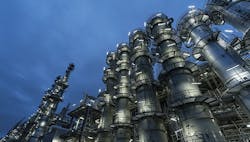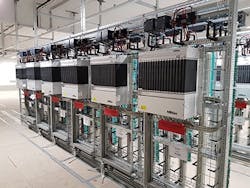BASF’s Ludwigshafen, Germany, site now includes a new world-scale production facility with the capacity to produce 90,000 mt/y of acetylene. The process uses raw materials very efficiently, providing high yield, while the heat given off during production will serve for generating energy. Around 20 production units at the Ludwigshafen complex use acetylene as a starting material for a wide variety of products.
The construction site spanned 40,000 m2. Around 750 employees and contractors usually worked on the site every day, rising to as many as 1,500 people per day in peak times. The plant required a total of 35,000 m3 of concrete and 8,500 mt of steel.
The facility includes 440 customized columns, machines and appliances; these were manufactured in 12 different countries and also in BASF factories. Some components spent up to eight weeks in transit to Ludwigshafen.
The longest component manufactured specifically for the facility — a 60-m long and 225-mt column — was transported by ship to Ludwigshafen and lifted to its final position in April 2018 by a crawler crane and a 1,000-mt mobile crane.
The site also features a 90-km-long pipeline network.
Ensuring Process Safety
When it came to planning and implementing functional safety, BASF opted for state-of-the-art safety technology from HIMA, Brühl, Germany. This consists of hardware, software and engineering to protect and secure safety-critical production processes in this complex project.
Meinrad Rämisch, senior E&I engineering manager at BASF, explains: “We have been working successfully with HIMA at the Ludwigshafen site for many years and have found the experience with our partner’s safety solutions to be excellent. It seemed logical to also rely on HIMA’s technology and expertise for the new acetylene plant.”
In the new acetylene facility, HIMA’s controllers not only perform classic emergency shutdown duties but also handle the complex functions involved in starting up and controlling the equipment. The SafeEthernet protocol ensures safe cross-communication between controllers at safety integrity level 3 (SIL 3). Fast response times in the event of a safety shutdown and the high operational safety (SIL 3) within safety-critical production processes contribute to the acetylene plant’s high availability and productivity. Additionally, the HIMax hot-swap function enhances the future-safe design of the unit as redundancy allows implementation of upgrades during operation.
“The regular DCS, SIEMENS PCS7, handles all basic process control functions of the acetylene plant including the complete operation and monitoring,” notes Rämisch. “All safety-related tasks are controlled with the subordinated HIMA HIMax system, dominantly. These tasks include the qualified management of various burner systems with [their] startup and shutdown sequences. These sequences are synchronized with the DCS operation, again.”
Just-In-Time Delivery
HIMA and BASF started their joint work on this project in 2017. After the intense planning phase, in 2018 HIMA delivered 61 BASF control room racks based on a total of six HIMax systems (Figure 1). Integration of 103 X-HART modules into the HIMax controllers enables read-out of the field devices. HIMA wired and factory acceptance tested the HIMax controllers in-house and delivered the pre-assembled complete modules, including the separation layer, in accordance with the “just-in-time” requirements of the construction site. This ensured smooth installation and timely construction progress while relieving BASF of the effort for on-site basic wiring.
Figure 1. The acetylene plant features six pre-assembled Hi-Max systems with 103 integrated X-HART modules.
Despite the complexity of the project, the HIMax system provides a lean and highly reliable hardware package. The system, which can include 15 base plates with 18 input/output (I/O) slots in each controller, is extremely modular and flexible. Additionally, HIMA contributed its safety expertise right from the planning phase; HIMA engineers proactively assisted in designing the hardware and programming the application-specific software, in particular for implementation of the complex burner-control circuits. The resulting package then was easy to integrate into the specified DCS system.
The pre-assembled control room racks based on the HIMax systems were delivered in two stages, in April and July 2018. The overall package includes:
• 61 BASF control room racks;
• six HIMax systems with a total of 30 base plates (X-BASE PLATE);
• 103 X-HAR modules integrated in the six HIMax systems;
• 53 X-HART modules in four HIMax systems already successfully commissioned for reading data from the field devices;
• a laptop with the FieldCare software provided by HIMA from cooperation partner Endress+Hauser to display the values from the HART field devices;
• on-site testing of this laptop by HIMA together with BASF;
• over 270 I/O modules and 4,300 Ex signal isolators by sensor specialist Pepperl+Fuchs; and
• more than 7,000 hours of on-site engineering and service support.
Since October 2018, HIMA has permanently based two engineers in Ludwigshafen to ensure seamless integration of the safety system into the existing automation architecture and meeting of the commissioning schedule.
Ample Advantages
Some of the manifold benefits arising from this joint project deserve mention, starting with the X-HART modules integrated in the HIMax systems. From the moment commissioning began, the integrated modules allowed experts to determine if suitable field devices were in the right location and had the appropriate parameters. Secondly, non-stop, on-site service provided by HIMA specialists during the final phase ensured smooth commissioning and compliance with the tight schedule. BASF also benefited from flexible and efficient decision-making throughout the entire project. For instance, the “just-in-time” delivery of pre-assembled and tested control room racks reduced both overall cost and time.
Some beneficial effects are long lasting. The complete package not only protects and secures safety-critical production processes at the site but also will continue to ensure high availability and productivity of the new state-of-the-art acetylene facility by reliably safeguarding important functions during system operation. The HIMax controllers comply with all relevant standards (from IEC 61508 to EN 50156), meet SIL-3 requirements, and feature fast response times for emergency shutdown. Last but not least, HIMax redundancy and hot-swap functionality allow for system upgrades during operation, which, in turn, enable easy integration of future functions, e.g., for Industry 4.0 implementation at a later stage.
ANDREAS JAUSS is a project manager in the engineering and project management group of HIMA Paul Hildebrandt GmbH, Brühl, Germany. Email him at [email protected].

